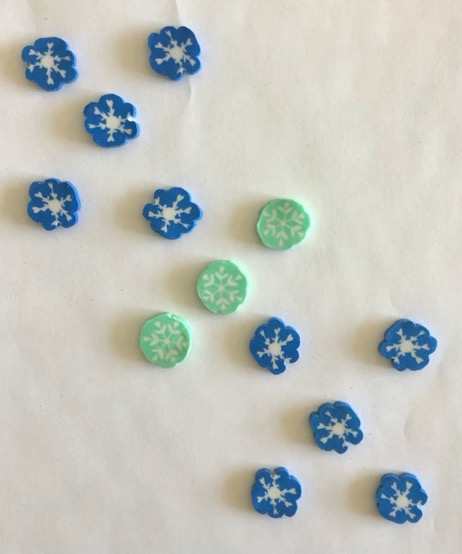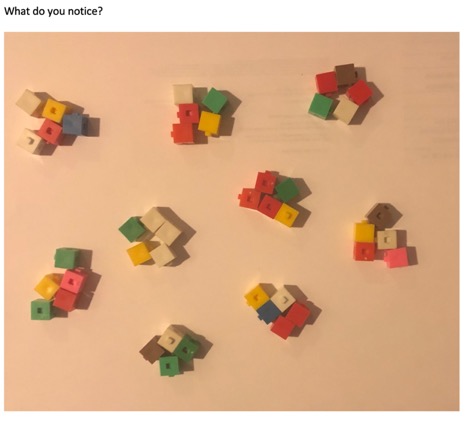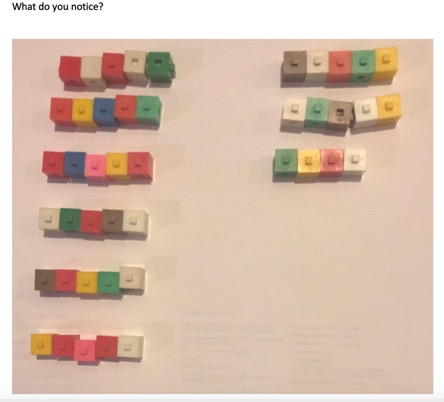Our school uses Cognitively Guided Instruction (CGI) to teach mathematics. At the beginning of the school year, one of my goals is to learn about students’ mathematical thinking and experiences. I typically begin the year with counting collections to observe, as well as to provide students with opportunities to learn and discover, one-to-one correspondence, how to skip count, and ways to group numbers to be able to count more efficiently and accurately. Counting collections lays the foundation of the base ten system and helps students make sense of number operations (e.g., addition, subtraction, multiplication and division). Students count a collection of objects. They may count these objects one at a time, or they may decide to group objects. Once students have counted and organized their collections, they record their counting. I conference with students individually or in small groups to understand their thinking and strategies, and if need be, focus on any areas of struggle. Students explain their thinking in partnerships, small groups, and whole-class discussions. The students and I learn from one another in this process.
For the 2020-2021 school year, I had to consider how to adjust this learning activity for the remote teaching and learning context. I often prepare collections for students in the classroom and vary the amount of objects that students will count. I teach in a multi-age classroom with students who are ages 6-8, which means that I need to differentiate the collections. Mathematicians in my class may work with collections of different sizes and experiment with a variety of counting strategies. When our school transitioned to remote instruction, I realized that finding “just right” collections could be a challenge. I needed to be able to teach with collections that students could find in their homes. In the remote classroom, I also had to figure out how to see what the students were counting, how they were counting, and how to facilitate collaboration among students. Partnerships often have discussions over how to organize a count, what to count first, and what tools and strategies may be best. Students learn so much from one another in the classroom from counting together and discussing what and how to count.
I decided to start the counting collections unit with images of collections, and I chose images to spark discussion of what or how to begin counting a collection. I would share the image and ask students: “What do you see?” “What do you notice?” “How many?” “How do you know?” “How did you count what you see?” “Are there other ways to count?” Below is an example of the kind of image that I used with my mathematicians who are new to counting collections. I took a picture of some mini snowflake erasers I had at home. I would display this image on the screen and ask: “How many?” Students may respond with: “ 13 snowflakes,” “10 blue snowflakes,” “3 green snowflakes,” “1 picture”, or they may try to count the lines in the snowflakes. Then I would ask them: “How did you count?” Students might say: “I counted one at a time.” With Zoom, I could also ask students to annotate the picture to show how they counted. They might skip count or count in groups.
During these whole-class conversations, I would listen to the students’ ideas. The conversations were an opportunity to validate my mathematicians’ thinking. If a student said, “one picture,” then they were right. It’s a creative response. I hadn’t even thought of that. For me, that’s really interesting. Our conversations about the images were an entry point for all of the learners. Everyone has an entry point. It builds identity. All students come to us having knowledge of mathematics. Sometimes students will come up with counting strategies that I hadn’t even thought of when I chose the image. These conversations allowed me to learn about the ways students were thinking about counting. My students were also able to hear how their classmates were counting. I want students to be able to apply these counting strategies when they’re counting on their own.
Initially, I wanted to show students a lot of images that they could count. Below are more examples of photographs that I used. These photographs sparked conversations about how mathematicians can organize their collection. I showed these three images in the same lesson.
After showing these images, and having a class discussion, students would go into breakout rooms on Zoom to count a collection of items that they had at home. We asked parents to make sure that their children had objects to count, and we listed a variety of options (e.g., beans, pasta, hair clips, legos). We did not give a number or range of objects that students would need. That was part of the exploration. For example, one student brought two bags of pinto beans, and we had a discussion of how they would count the beans. Maybe they would just count a handful or two handfuls of beans. Maybe they would pour some beans in a bowl and count what was in the bowl. Maybe they wouldn’t finish the counting collection by the end of math. In that situation, I might say, “Wow, you’ve counted to 40! I don’t want you to lose your progress. What could you do so that you don’t have to recount over again?” Maybe the student would put the 40 items in a bag and label it. I didn’t limit them. Students decided what was a “just right” collection for them. If they got tired while counting, maybe it wasn’t a “just right” collection for right now. If I set a limit on the size of the collection, I would also be limiting the math conversations that we would be able to have.
I found that it was best to have students count their collections in the breakout rooms, which was similar to asking students to work in small groups during in-person instruction. There would be a teacher or teaching assistant in each breakout room. The teacher or teaching assistant paid attention to what and how students were counting, and they answered any questions that students had. As much as we could, the teachers and teaching assistants tried to listen to individual students’ counting by unmuting one student at a time in the small group.
After students completed their count, they would take a picture of the collection and upload the picture to our learning management system. Students audio recorded an explanation of how they counted their collection, and they annotated the picture as they explained their process. By recording their thinking, students had an opportunity to rehearse their explanations. I listened to all of their recordings. As I listened to their recordings, I thought: “What can I learn from this mathematician? How might we learn together?” I replied to their recordings with validation, questions, and suggestions. Students then responded to my comments and questions. It was an incredible opportunity to hear each of my students’ thoughts and engage in dialogues with them about their work. When we return to in-person instruction, I plan to continue using the same learning management system so that I can have these dialogues with every student.
I would select one or two examples of student work to share with the class the next day. These examples might be either something that I observed in a breakout room or an example of a students’ recorded assignment. (I always asked the students for permission to share their work beforehand.) I shared the image or recording and asked the class what they noticed in the example. The mathematician was there to answer questions. Students learn a great deal when they have opportunities to discuss their thinking and counting. By listening to students’ thinking and questions, I also learned how to adjust future lessons to support students’ growth and mathematical understanding.



